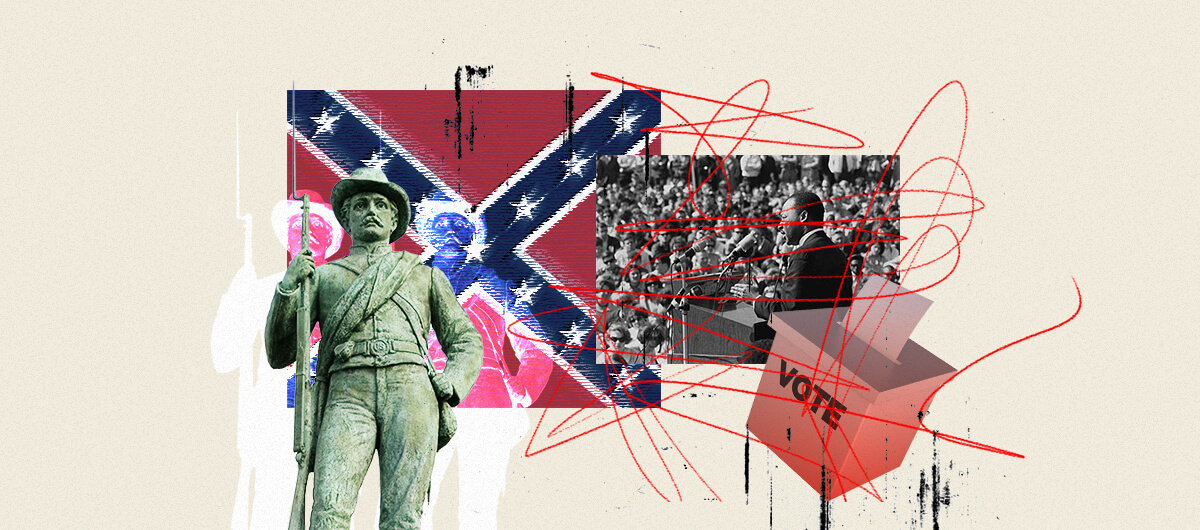

Explain This
The GOP’s New, NEW Jim Crow
One of this administration's biggest goals is enacting a 21st-century Jim Crow era. And with SCOTUS poised to further dismantle the Voting Rights Act, they may just pull it off.
This article was made possible because of the generous support of DAME members. We urgently need your help to keep publishing. Will you contribute just $5 a month to support our journalism?
Republicans and Trumpers haven’t been subtle about their attacks on the Civil Rights Movement and its legacies. One of the talking points of the late Charlie Kirk was that the 1964 Civil Rights Act had been a mistake. But Kirk, a notorious racist, was just one person among many hoping to tear down the accomplishments of the movement. Hugh Hewitt, a conservative activist, radio show host, and reliable administration mouthpiece, has applauded Trump for going after the 1964 Civil Rights Act.
What the administration wants is a new Jim Crow era, updated for the 21st century. It won’t perfectly resemble what came before: Black people may not face the widespread daily reality of segregation in public facilities for example (though the same cannot be said for transgender individuals, whose existence in public is being challenged). It will be far greater in scope though than what lawyer and civil rights activist Michelle Alexander described in her best-selling book The New Jim Crow, because this will extend far beyond the criminal justice system.
What was Jim Crow? In brief, it was the legal and extralegal system that upheld white supremacy in the South and elsewhere. The name comes from an 1828 song, “Jump Jim Crow” that was part of the minstrel tradition: White performers donning blackface and acting out skits while reinforcing crude stereotypes about African Americans. Jim Crow became a nickname for Black Americans, and in the 1890s it became the name for this new system. The end of Reconstruction in 1877 meant that federal protections for African Americans were gone — the last troops left as part of the Compromise of 1877. It took some time for new laws to be passed, but in 1885, Florida passed a law segregating train cars. In 1890, Mississippi passed a new constitution requiring that poll taxes and literacy tests be requirements for voting. It excluded some poor whites from government, but that was an acceptable cost for creating a new white power structure. After the Supreme Court case of Plessy v. Ferguson ruled that separate but equal was legal in 1896, Jim Crow segregation became widespread and remained in place into the 1960s.
One of the critical things to understand about Jim Crow is that it extended beyond segregation and being treated like second-class citizens, like being forced to drink at separate fountains and sit at the back of the bus. Those optics were important in order to establish social hierarchies and a pervasive sense of “us vs. them.”
But because of Jim Crow, white Southern Democrats created white nationalist state governments that they controlled, and limited economic opportunities available to African Americans to generate a stable supply of labor in agriculture. Jim Crow laws operated through numerous “colorblind” policies that were designed to look neutral but which in practice were discriminatory. These laws allowed Southern states to transform themselves into one-party dictatorships where power was consolidated in the hands of whites.
This is the example Trump wants to emulate — and replicate on a national scale.
The Trump administration is working as hard as it can to gut every legal protection and advancement achieved by the Civil Rights Movement. The Voting Rights Act of 1965, which had been one of our best protections against gerrymandering, has already been strategically weakened by the Supreme Court over the course of a decade, beginning with Shelby Counter v. Holder in 2013. Right now, the Supreme Court is preparing to weigh in on whether states have a legal obligation to create majority-Black districts in Louisiana v. Callais. If the court decides that there is no obligation, it makes it that much easier to gerrymander states along racial and party lines.
But that’s just one component. The whole architecture of federal civil rights protection either has been dismantled or is under threat right now. The Civil Rights Act of 1964 has been under attack by the Trump administration basically since Trump’s inauguration: Agencies have been directed to stop investigating whether laws disproportionately target one group. The Office of Environmental Justice and External Civil Rights, which investigated environmental racism, was shuttered in March. The same has happened in the Social Security Administration, the Department of Homeland Security, and the Department of Veterans Affairs. Housing discrimination enforcement is being gutted. The federal government’s commitments to protecting people’s rights are being systematically rolled back to a pre-1960s era.
And then there’s the assault on “DEI,” which has become a vague catchall for anything the administration dislikes. One way that Republicans have begun using the term “DEI” is telling: They say “DEI hires” to imply that a person is not actually good at their job, so they can demean and then fire them. Of course, this is their way to push women and Black, brown, LGBTQ, and disabled people out of the workplace. African-American women have been disproportionately affected by the administration’s federal layoffs and grant terminations, a doubly painful blow because public-sector employment is a path to economic stability. What it amounts to is a growing de facto resegregation of the workforce, one that dramatically weakens communities of color.
But more than just erasing legal protections or rolling back laws, the administration is trying to revive the white nationalism that was baked into the Jim Crow worldview. Vice-President JD Vance has been the spokesman for this. “I think the people whose ancestors fought in the Civil War have a hell of a lot more claim over America than the people who say they don’t belong,” Vance said in a speech a few months ago at the Claremont Institute. As Jamelle Bouie has written, this is in effect rolling back the clock on what citizenship means: The full rights and benefits of citizenship belong to white people because white people are imagined to have a more central role in the country’s history. Everybody else here is on sufferance even if they are citizens.
To create this 21st century Jim Crow, the administration has to rebuild a common white nationalist and white supremacist ethos. This is why the administration has been so keen to restore Confederate War memorials or put the names of Confederate generals back on to military bases. (This was an early preoccupation of Stephen Miller, who, as early as 2015, was trying to work with Breitbart to force Amazon to resume selling Confederate memorabilia.) Many of those monuments were themselves an artifact of the Jim Crow era, part of an experiment in creating national unity. The differences between the Confederacy and Union were deliberately papered over, and instead of depicting Confederates as traitors they became quixotic patriots or worse, defenders of a white, “Anglo-Saxon” political system.
One of the paradoxes of this system is that, while members of the Trump administration are clearly racist, they continually talk about “merit” or building a “colorblind” society. How can these two things coexist? It’s actually a baked-in feature of this system. It denies that systemic racism exists; the dominance of white people economically and politically is just supposed to be “normal” and unquestioned.
There are even political strategies being readopted from the Jim Crow era. In Georgia, white segregationists maintained power at the state level in part through a system known as the county unit system. Innocuously named, the county unit system was used to determine who won state primaries by allocating votes to different counties. Because rural counties outnumbered urban counties but were worth the same number of “votes,” rural voters dominated Georgia politics for decades. The Texas GOP proposed a very similar system last year.
Once in power, a system like this is extremely difficult to dislodge because of the hierarchies that it establishes. Even though many Jim Crow laws targeted and marginalized poor whites as well, it still built a hierarchy that gave poor whites a sense of superiority. President Lyndon Johnson was quoted once as saying, “If you can convince the lowest white man he’s better than the best colored man, he won’t notice you’re picking his pocket. Hell, give him somebody to look down on, and he’ll empty his pockets for you.”
There’s truth to this: Mississippi in the 1930s had two senators, Pat Harrison and Theodore Bilbo. Bilbo’s support came from poor white farmers in the northern part of the state, but despite having issues in common with African Americans he proved to be the more vehement racist of the two: He routinely tried to pass legislation that would deport African Americans to Liberia.
Even Northerners learned to accommodate themselves to this reality. Republicans who had previously supported civil rights and Reconstruction stopped after the 1880s and increasingly only offered rhetorical support. Why? The constant division and infighting between Democrats and Republicans stemming from the Civil War was too much of a political obstacle. Backing off of civil rights and embracing national unity made bipartisanship and governance easier. Racism itself was plentiful in the North, and Southern attitudes trickled into the North. By 1908, Springfield, Illinois, the home of Abraham Lincoln had experienced a race riot with lynchings. Republicans are likely hoping that more cynical Democrats will go along with this and stop pushing back.
This will probably take a little while before the full effects are realized. That is what makes it so dangerous: It encourages moderates to dismiss what’s happening. The end of Reconstruction did not segue into the immediate onset of Jim Crow; it took several years before segregation laws were passed, and it wasn’t until the 1890s that it became widespread throughout the South. Virginia, North Carolina, and even Mississippi had African American congresspeople in the House of Representatives in the 1880s and 1890s; the last person to serve, George Henry White of North Carolina, was elected in 1897. Things can appear normal and give you hope that they’ll get better on their own when they very clearly won’t.
The encouraging thing is that, for now, the imposition of a new Jim Crow is still very unpopular. While red states will have an easier time going along with changes at the federal level, there is no popular groundswell crying out for this to happen. Blue states meanwhile have a chance to set themselves up as leaders on the issue, acting as safe havens on the one hand and criticizing the federal government with the other. Keeping the fight up is critical, because once you yield it will become much more difficult to restore.
Before you go, we hope you’ll consider supporting DAME’s journalism.
Today, just tiny number of corporations and billionaire owners are in control the news we watch and read. That influence shapes our culture and our understanding of the world. But at DAME, we serve as a counterbalance by doing things differently. We’re reader funded, which means our only agenda is to serve our readers. No both sides, no false equivalencies, no billionaire interests. Just our mission to publish the information and reporting that help you navigate the most complex issues we face.
But to keep publishing, stay independent and paywall free for all, we urgently need more support. During our Spring Membership drive, we hope you’ll join the community helping to build a more equitable media landscape with a monthly membership of just $5.00 per month or one-time gift in any amount.




















































































